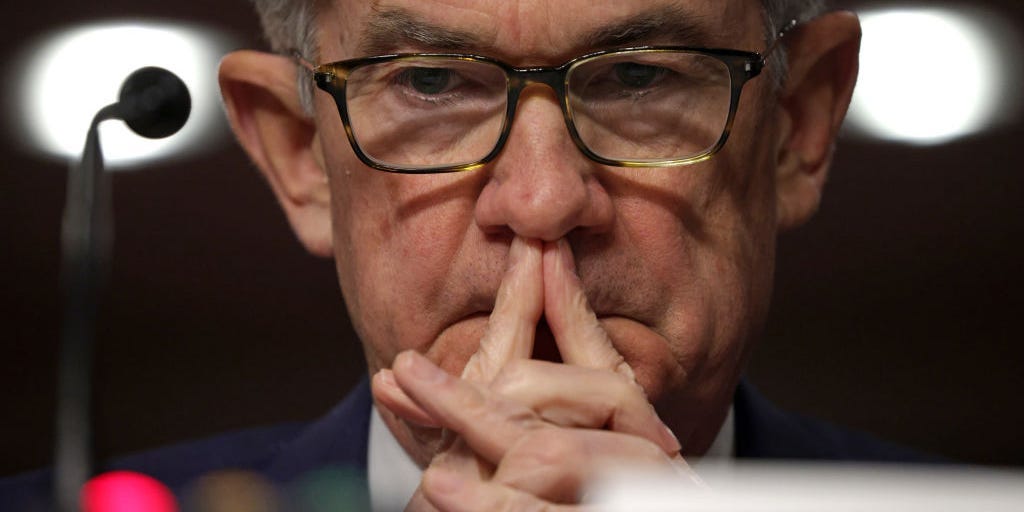The war in Ukraine complicates the Fed’s plan to tackle inflation via rate hikes, experts told Insider. The Federal Open Market Committee will hold its first meeting of 2022 on March 15 and 16. Powell is likely to de-emphasize forward guidance at his press conference. Loading Something is loading.
The war in Ukraine won’t throw the Federal Reserve from its goal of taming hot inflation but it worsens the central bank’s visibility on making numerous and aggressive policy moves, market professionals tell Insider.
The Fed’s meeting on March 15 and 16 is set to take place as Russia presses on with its invasion of Ukraine, which has sparked a subsequent surge in commodity prices. US inflation is at a fresh 40-year high of 7.9%, a rate that doesn’t capture US gas prices that have spiked since the war began late last month. The COVID pandemic, meanwhile, wears on.
“The shock from Russia-Ukraine doesn’t clearly point to the Fed being more dovish or more hawkish than they were prior to this because it’s a negative shock to [economic] growth as well as a positive shock to inflation,” Bill Adams, chief economist at Comerica Bank, told Insider. “It makes it harder for the Fed to balance their dual mandate with the shock pushing both of their objectives further from their goal.”
The Federal Open Market Committee is expected to raise its benchmark interest rates by 25 basis points next week. Policymakers slashed the federal funds rate to a range of 0%-0.25% in 2020 as part of their emergency response to the pandemic.
“The market is pricing in a pretty aggressive pace of tightening despite all of the turmoil taking place right now in the economy,” Kathy Jones, chief fixed-income strategist at Charles Schwab, told Insider. She said that as of this week, investors were pricing in five more rate hikes after the March meeting.
However, “I think the thing to emphasize right now is anybody who has confidence in their projections is being naïve. We’ve just have not been here before. The confluence of events is so unusual that everybody’s projection should be taken with a grain of salt, including mine,” said Jones.
Earlier this year, federal funds futures showed investors pricing in as many as seven rate hikes, she said. Markets were positioned for rate increases of 160 basis points this year through more than six rate hikes, ING said in a note Friday.
Adams and Jones expect Federal Reserve Chairman Jerome Powell next week to indicate the Fed will make monetary policy decisions on a meeting-by-meeting basis rather than take a broad-stroke approach to inflation as it previously suggested.
Investors anticipated an increase of 50 basis points at the March meeting after the Fed last year shifted gears to signal it would tackle high inflation. But that view has changed, and the CME FedWatch tool showed a 0% probability of a half-percentage point rate increase next week compared with a 34% probability in late February.
“I don’t think the Fed knows what they’re going to do yet. They are clearly going to have to caveat things with, ‘It depends on conditions,'” she said.
Pain at the pump
Conditions include West Texas Intermediate crude oil and Brent crude prices shooting up as much as 40% after the war started. That’s led to the national average for gas prices reaching $4.33 a gallon on Friday, according to Triple-A. Goldman Sachs on Friday said the odds of the US economy falling into recession are as high as 35% as soaring commodity prices hit household spending.
Adams expects Powell to de-emphasize forward guidance at Wednesday’s press conference.
“He genuinely knows less what the outlook is going to be six months from now, three months, or even one month from now. Economists’ tools are not effective at predicting the outcome of situations like this,” Adams said.
The war also complicates the Fed’s decision-making on reducing its $8.7 trillion balance sheet as it would prefer to announce a plan with advance notice of a couple of months, Adams said.
“The Fed may be forced to tweak their balance sheet reduction plan in real-time if the Russia-Ukraine shock causes big revisions to the outlook for the economy,” he said.
Schwab anticipates four rate hikes this year and for the Fed to start drawing down its balance sheet beginning in July.
“That’s a fair amount of tightening that would take place in a matter of four or five months,” Jones said.
Adams forecast a quarter-percentage-point increase next week, then four more hikes of the same size by the end of 2022. Overall, “this is like you’re driving in a snowstorm,” he said, “and all of a sudden, the snow starts coming down harder and visibility goes down. You can’t see as far in front of you as you could prior to this new shock.”
